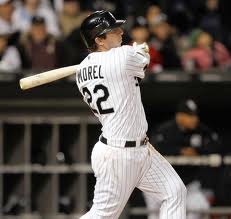We at Off The Bench have been looking at what happens when we shakeup the lineup based on certain statistical parameters. Yesterday’s post looked at putting Michael Born in the 4th spot in the Atlanta Braves lineup and sticking Prince Fielder in the two-hole. It may seem like a dumb idea at first, but given that Joe Maddon is hitting Carlos Pena in the leadoff spot, I’d say a bunch of the smart guys in baseball are rethinking their lineups. The idea here is that by emphasizing a given statistic, a lineup can be created that maximizes run production. Today’s statistic: Batting Average.
AVG
Average is one of the stats that the sabermetric guys are working feverishly to dismiss from baseball rhetoric. The problem is that the stat is so entwined with how you’re hitting and performing regardless of its long standing, silly rules (who says that a sac bunt shouldn’t count against your average or that a double play shouldn’t count for twice as much?). Traditional managers and traditional lineup strategies value average, hits, and getting on base. With that, let’s look at how the Los Angeles Angels and Chicago White Sox might construct their lineup valuing average:
Los Angeles Angels of Anaheim (2012 averages in parenthesis):
- Mark Trumbo (.333)
- Mike Trout (.306)
- Kendrys Morales (.294)
- Howie Kendrick (.263)
- Torii Hunter (.256)
- Albert Pujols (.232)
- Erick Aybar (.216)
- Peter Bourjos (.207)
- Chris Iannetta (.197)
Los Angeles Angels of Anaheim (Career Average):
- Albert Pujols (.325)
- Howie Kendrick (.291)
- Kendrys Morales (.285)
- Torii Hunter (.273)
- Erick Aybar (.271)
- Mark Trumbo (.267)
- Mike Trout (.261)
- Peter Bourjos (.248)
- Chris Iannetta (.233)
Chicago White Sox (2012 Average):
- Paul Konerko (.395)
- A.J. Pierzynski (.306)
- Alejandro De Aza (.286)
- Alex Rios (.274)
- Dayan Viciedo (.268)
- Adam Dunn (.241)
- Gordon Beckham (.224)
- Alexei Ramirez (.216)
- Brent Morel (.177)
Pros: The pros are simple and obvious. You get the guys who get a bunch of hits and put them together at the top of the lineup. The same stance that was present in the OBP argument is seen here. The difference in the lineup for 2012 versus career average is startling especially given Albert Pujols’ slow start. He seems to have turned it around a bit and that’s why I included the career averages lineup for the Angels. I especially like the lineup shakeup for the White Sox. They finally get Gordan Beckham out of the way and get Paul Konerko as many at bats as possible.
Cons: OBP may function in the same way, but with the White Sox Adam Dunn is moved slightly down (to the 6th spot) and with the Angels the completely impatient Erick Aybar is moved up to the 5th spot in the career average lineup. Additionally, with average guys like Vladimir Guerrero, or Jeff Francouer who refuse to take walks, may be poor table setters for the guys behind them. I also forsee an issue wherein the guys who have low averages get out a bunch with a bunch of guys on base in front of them. Think about Alex Rios and his career .323 OBP trying to drive in a bunch of guys.
The Bottom Line: There’s certainly worse ways to construct a lineup than by emphasizing batting average. However, you have to be careful not to fall victim of the small sample size argument and keep a table-setter type at the top of the lineup for guys like Paul Konerko. I really don’t like the idea of Paul Konerko hitting behind Brent Morel, Alexei Ramirez, and Gordan Beckham and the 38.3% chance that none of the three will get a hit. The problem with this lineup construction is the same problem with batting average as a whole: it does not value those who take a walk. Still, it’s obvious that sometimes managers should take a look at some stats before blindly filling out the lineup card and leaving Gordan Beckham and his inability to get a hit in the two-whole because he’s a “prototypical two hitter.”
Stat of the Day: Jordan Schafer has a .373 BABIP but only a .260 average. Expect him to regress as the season moves along.
-Sean Morash















